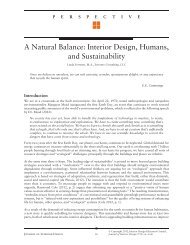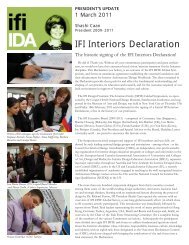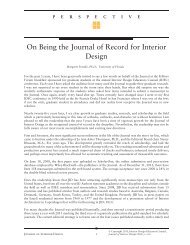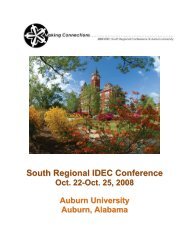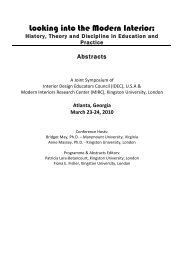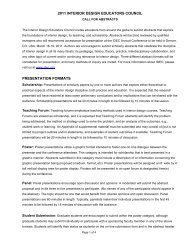What's in a Name? Interior Design and/or Interior Architecture: The ...
What's in a Name? Interior Design and/or Interior Architecture: The ...
What's in a Name? Interior Design and/or Interior Architecture: The ...
You also want an ePaper? Increase the reach of your titles
YUMPU automatically turns print PDFs into web optimized ePapers that Google loves.
P E R S P E C T I V E‘‘. ..Even architects face marg<strong>in</strong>alization by quasi-professionals, s<strong>in</strong>ce a large segment ofthe built environment is still not designed by architects. Both groups need to recognizetheir unique skills <strong>and</strong> contributions, <strong>and</strong> not participate <strong>in</strong> a turf war over practicerecognition <strong>and</strong> legislation.’’Education Research (now the Council f<strong>or</strong> <strong>Interi<strong>or</strong></strong> <strong>Design</strong> Accreditation <strong>or</strong> CIDA) first began accredit<strong>in</strong>gprograms <strong>in</strong> 1973 (Mart<strong>in</strong>, 2008). Today, there are 145 accredited Bachel<strong>or</strong>’s degree <strong>in</strong> <strong>in</strong>teri<strong>or</strong> designprograms nationally (M. Scanlan, personal communication, May 26, 2009). In addition, <strong>in</strong>teri<strong>or</strong> design hasidentified its own separate <strong>and</strong> dist<strong>in</strong>ct codified body of knowledge (Guer<strong>in</strong> & Mart<strong>in</strong>, 2001), a key element<strong>in</strong> def<strong>in</strong><strong>in</strong>g a profession acc<strong>or</strong>d<strong>in</strong>g to Grimm <strong>and</strong> Kronus (1973).Identity <strong>in</strong> the Legislative ArenaIn the legal arena, the NCIDQ was founded <strong>in</strong> 1974 f<strong>or</strong> the purpose of establish<strong>in</strong>g st<strong>and</strong>ards of competencef<strong>or</strong> designers to protect the health, safety, <strong>and</strong> welfare of the public (NCIDQ, 2009). F<strong>or</strong> those of us who teach<strong>in</strong> <strong>or</strong> have graduated from CIDA-accredited programs, protection of the public health, safety, <strong>and</strong> welfare isat the very c<strong>or</strong>e of what we do. Currently there are nearly 25,000 NCIDQ certificate holders (Friend, 2009),<strong>and</strong> <strong>in</strong>teri<strong>or</strong> design is regulated <strong>in</strong> 25 states, territ<strong>or</strong>ies, <strong>and</strong> the District of Columbia (J. Kenney, personalcommunication, February 18, 2009). A comprehensive exam<strong>in</strong>ation <strong>and</strong> legal regulation are two of the sevensteps necessary to move from a practice to a profession (Mart<strong>in</strong>, 2008). However, this is the area where<strong>in</strong>teri<strong>or</strong> design is com<strong>in</strong>g under fire from the Institute of Justice, <strong>Interi<strong>or</strong></strong> <strong>Design</strong> Protection Council, <strong>and</strong>the NKBA, among others (IDPC, 2008). <strong>The</strong> IDPC (2008) argues ‘‘it is not the function of the legislatureto enhance the stature <strong>or</strong> respect of a profession’’ (p. 19). Further, the IDPC contends that the practice of<strong>in</strong>teri<strong>or</strong> design has little <strong>or</strong> noth<strong>in</strong>g to do with protection of the public health, safety, <strong>and</strong> welfare, an argumentthat Mart<strong>in</strong> (2008) effectively refutes (see also Guest, 2008). Institute of Justice advocates Carpenter <strong>and</strong> Ross(2008) suggest that their constituents’ First Amendment rights are be<strong>in</strong>g violated <strong>in</strong> that they are unable tocommunicate effectively with the public about the scope of their services, <strong>and</strong> their economic viability <strong>in</strong>the marketplace is be<strong>in</strong>g harmed. NKBA (2008) effectively sums up the argument when they state: ‘‘Suchlaws harm the public by artificially <strong>in</strong>flat<strong>in</strong>g consumer prices, erect<strong>in</strong>g unnecessary barriers to entry <strong>in</strong>to theprofession, giv<strong>in</strong>g government-imposed advantages to those already practic<strong>in</strong>g <strong>and</strong> fail<strong>in</strong>g to demonstrate anysocial benefit’’ (p. 3). In response, ASID has issued the follow<strong>in</strong>g statement: ‘‘ASID will cont<strong>in</strong>ue to supp<strong>or</strong>tlegal recognition of the <strong>in</strong>teri<strong>or</strong> design profession, but not if that recognition prevents <strong>in</strong>dividuals from offer<strong>in</strong>gbasic <strong>in</strong>teri<strong>or</strong> design services as they have <strong>in</strong> the past’’ (Brigham, 2009, p. 106). Until both the legislative arena<strong>and</strong> the public underst<strong>and</strong> that <strong>in</strong>teri<strong>or</strong> design is different from <strong>in</strong>teri<strong>or</strong> dec<strong>or</strong>ation, these cont<strong>in</strong>u<strong>in</strong>g battleswill extract a toll on the profession. Yet as architect Richard Logan rem<strong>in</strong>ds us:‘‘Official recognition, even f<strong>or</strong> architects, is perhaps not a century old. <strong>Interi<strong>or</strong></strong> designers have onlybegun the ardent process with<strong>in</strong> the past few decades, <strong>and</strong> there is both impatience <strong>and</strong> competitionthat each group faces. Even architects face marg<strong>in</strong>alization by quasi-professionals, s<strong>in</strong>ce a largesegment of the built environment is still not designed by architects. Both groups need to recognizetheir unique skills <strong>and</strong> contributions, <strong>and</strong> not participate <strong>in</strong> a turf war over practice recognition <strong>and</strong>legislation. (Bowles, 2007, p. 11)Identity <strong>in</strong> the Public Arena<strong>Interi<strong>or</strong></strong> design has met all seven of the steps outl<strong>in</strong>ed <strong>in</strong> professionalization the<strong>or</strong>y to move from a practiceto a profession. <strong>The</strong>se steps <strong>in</strong>clude: (1) name change (<strong>in</strong>teri<strong>or</strong> dec<strong>or</strong>ation to <strong>in</strong>teri<strong>or</strong> design; (2) educationrequirements; (3) comprehensive exam<strong>in</strong>ation; (4) legal recognition/regulation; (5) professional <strong>or</strong>ganizationsmembership; (6) code of ethics; <strong>and</strong> (7) cont<strong>in</strong>u<strong>in</strong>g education (Mart<strong>in</strong>, 2008). Although <strong>in</strong>teri<strong>or</strong> design hasfulfilled all seven of these criteria, <strong>in</strong> this complex w<strong>or</strong>ld, the profession is still seen by many as little m<strong>or</strong>e than‘‘fluff’’ (Bowles, 2008). It would behoove us to revisit the analytical framew<strong>or</strong>k f<strong>or</strong> study<strong>in</strong>g occupationalJournal of <strong>Interi<strong>or</strong></strong> <strong>Design</strong> xvVolume 35 Number 1 2009





